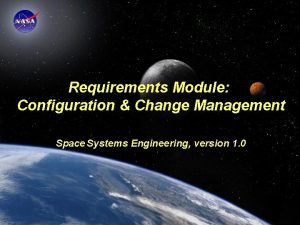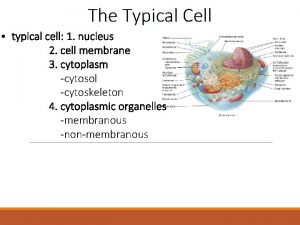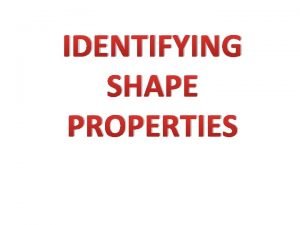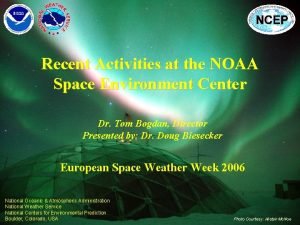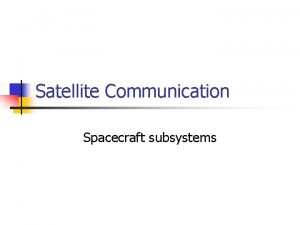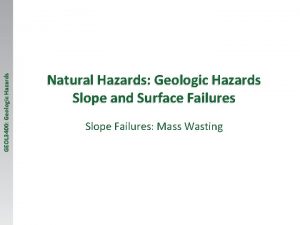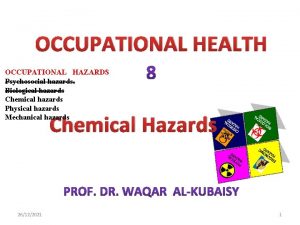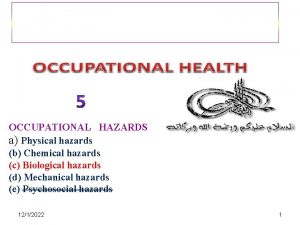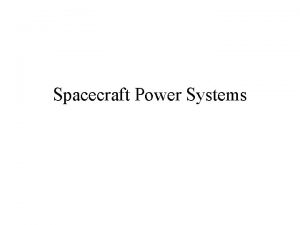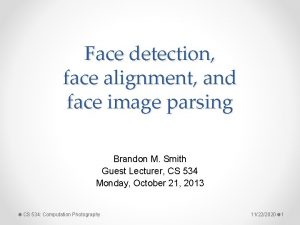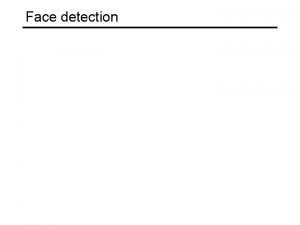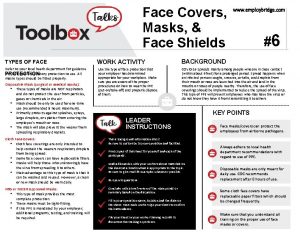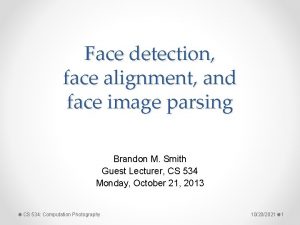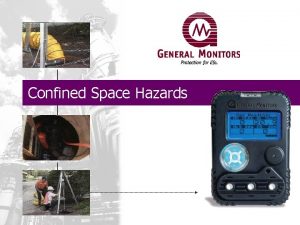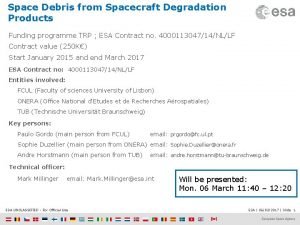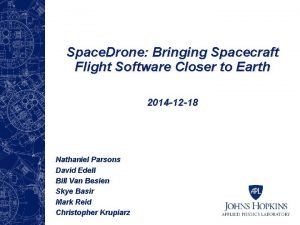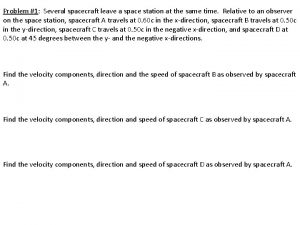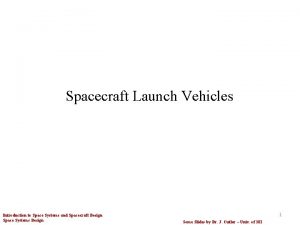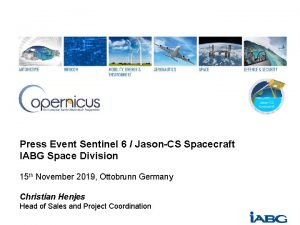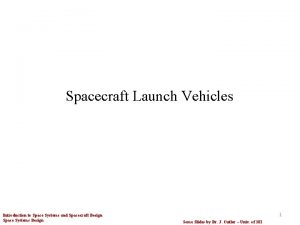Space Environment The Hazards Spacecraft face in a





























- Slides: 29

Space Environment The Hazards Spacecraft face in a near perfect vacuum environment. 1 http: //4. bp. blogspot. com/_ro 4 M 93 m. Vo 6 c/TJp 8 FHxf. Th. I/AAAAAM/POOg_3 Cf. Ac/s 1600/070801_EX_astronaut. EX. jpg

Learning Targets I can define a perfect vacuum environment and a “hard” or “near” vacuum environment. I can identify and explain the factors that contribute to a “near” vacuum environment. . I can explain the hazards of a vacuum environment. I can explain prevention strategies for designing a satellite to 2 survive in a vacuum environment.

Watch the following video about testing a space suit. Write down 3 to 5 observations about a vacuum environment. http: //www. youtube. com/watch? v=KO 8 L 9 t. KR 4 CY 3

Designing spacecraft to survive in the hazardous space environment is a challenge. All it took to punch this 0. 025 -cm hole in a U. S. satellite was a paint chip moving at hypervelocity. When the shuttle brought back the sat, scientists found six holes per square foot. NASA Cold welding Space junk outgassing Just a few of many 5

What do you Know about a vacuum? What is it? Where is it? What causes it? 6

Vacuum environments A pure vacuum, by the strictest definition of the word, is a volume of space completely devoid of all material. With gas molecules 7 Without gas molecules

In practice, however a pure vacuum is nearly unattainable. Even at an altitude of 960 km (596 mi), we still find about 1, 000 particles per cubic centimeter. So when we talk about the vacuum of space, we’re talking about a “near” or “hard” vacuum. 7

Atmospheric Density decreases with height. Atmospheric pressure represents the amount of force per unit area exerted by the weight of the atmosphere pushing on us. 8 Under standard atmospheric pressure at sea level, air exerts more than 101, 325 N/m 2 (14. 7 lb/in 2) of force on everything it touches. Predict what happens to the pressure as the altitude increases.

Atmospheric pressure decreases exponentially with altitude. 9

What causes most of the atmosphere’s molecules to be close to the earths surface? Force of gravity!!! 10

So where does space begin? The atmosphere gradually thins with increasing altitude so there is no tangible boundary between Earth's upper atmosphere and Space. The most widely accepted altitude where Space begins is 100 kilometers, which is about 62 miles. Link to altitude chart: http: //www. spacetoda y. org/Sol. Sys/Earth/Al titudes. Chart. html 11

Rate which orbit would have the greatest to least density. 12

Oh no what a Drag! Although it meets the definition of outer space, the atmospheric density within the first few hundred kilometers is still sufficient to produce significant drag on satellites. Drag is the force on an object that resists its motion 13

Satellites in Low Earth Orbit would experience the most atmospheric drag The following video link is a link to “This Week @ NASA” news show. The fourth segment “Ride the Wind” (4: 22) shows a wind tunnel demonstrating drag. http: //www. youtube. com/watch? v=x. Mvl 3 z 8 q. Fn. Q 14

The effect of drag on a spacecraft depends on several variables: Spacecraft speed Shape Size Orientation to the airflow DANDE (Drag and Atmospheric Neutral Density Explorer) http: //events. eoportal. org/presentatio ns/5/10002120. html Read through the articles provided to you by your teacher about spacecrafts that have specific designs to compensate for to much drag or not enough

How to get through the density of the atmosphere? Euro ion-rocket sat Designed to skim through the extreme upper atmosphere using ion drives to compensate for air drag http: //www. theregister. co. uk/2009/03/17/goce_get s_up_there/ Maintaining satellite attitude or orientation in space is a challenge in space (near vacuum) Gravity Probe B (GP-B) mission spacecraft For the GP-B experiment, an unprecedented amount of on-orbit control was required for the vehicle to maintain its drag-free flight in orbit. This was accomplished by harnessing the helium gas that continually evaporates from the dewar’s porous plug and venting it as a propellant through eight pairs of opposing or balanced proportional micro thrusters. http: //einstein. stanford. edu/TECH/tech nology 2. html

Atmospheric Drag in orbit can cause orbital decay. Orbital Decay (loss of altitude due to reduced speed) In 1979, the Skylab space station succumbed to the longterm effects of drag and plunged back to earth. http: //www. videojug. com/fi lm/the-skylab-space-station Video is 1: 55 long

Beyond the thin skin of Earth’s atmosphere is the vacuum of space that challenge space craft engineers. Three potential problems for spacecraft are: Out-gassing = (release of gases from spacecraft materials) Cold-welding = (fusing together of metal components) Heat transfer = (limited to radiation)

Out-gassing also known as “off-gassing” Out-gassing is the release of a gas that was dissolved, trapped, frozen, or absorbed in some material. When you get into your car and it has that “new car smell” is a common real world example

In a low pressure environment the problem of out-gassing is increased.

In space-based equipment, released gas can condense on such materials as camera lenses, rendering them inoperative. Solutions: Laboratory testing to select materials that have low out-gassing properties in a “near” vacuum environment. Moisture sealants, lubricants, and adhesives are the most common sources, but even metals and glasses can release gases from cracks or impurities. The industry standard test for measuring outgassing in adhesives and other materials is ASTM E 595. Developed by NASA to screen low-outgassing materials for use in space, the test determines the volatile content of material samples placed in a heated vacuum chamber. http: //www. masterbond. com/certifications/ asa-low-outgassing

Before being put into orbit, spacecraft are placed into a thermal-vacuum chamber for a process called “bake-out”. Why would they do this? Thermal Vacuum Chamber at NASA Goddard By Corrie Davidson | Published October 27, 2010

What is cold-welding? Cold welding occurs between mechanical parts that have very little separation between them. Or cold welding will occur when the lubricant between moving mechanical parts outgas or evaporate.

Possible solution for cold-welding. Ground controllers must try different strategies to “unstick” the two parts. One strategy is to expose one part to the Sun and the other to shade so that differential heating causes the parts to expand contract. Lubricants that don’t evaporate or outgas must be used. For example solid molybdenum-disulphide is an example of lubricant that will not evaporate or outgas.

How is heat managed in a “near vacuum”? Heat transfer in and out of a satellite is a unique problem in a near vacuum. Mechanical systems create heat that can degrade spacecraft systems. In a laptop, fans are used to transfer heat out of the system. That is not possible in a vacuum.

Methods of heat transfer. Convection takes place when gravity, wind, or some other force moves a liquid or gas over a hot surface. Conduction is heat flow directly from one point to another through a medium. Radiation is the transfer of heat through space by electromagnetic waves without a medium. Based upon the three definitions, which method is the best way for a spacecraft to transfer heat into a vacuum?

Solutions for heat transfer. . . Thermacore loop heat pipes are at work in aerospace and satellite thermal management applications, helping designers meet the strictest specifications and deal with the most rugged operating environments. http: //www. thermacore. com/products/loopheat-pipes-and-loop-devices. aspx http: //www. ecnmag. com/Articles/ 2010/11/Main-Circuit/Passive. Heat-Transfer-Devices/

Staying Cool on the ISS (International Space Station) http: //science. nasa. gov/science-news/science-at-nasa/2001/ast 21 mar_1/ In a strange new world where hot air doesn't rise and heat doesn't conduct, the International Space Station's thermal control systems maintain a delicate balance between the deepfreeze of space and the Sun's blazing heat. Read the Article “Staying Cool on the ISS” Consider the following questions: 1. What would it be like without thermal control on the ISS. 2. List and describe the specific design considerations for thermal control.

Radiation and charged particles from the Sun and the rest of the universe can severely damage unprotected spacecraft. Read the following article from Scientific American about “Solar Storms: Effects on Satellites” http: //www. scientificamerican. com/article. cfm? id=solarstorms-effects-on-satellites
 Spacecraft requirements management
Spacecraft requirements management Pros and cons of telephone interviews
Pros and cons of telephone interviews Phospholipid bilayer
Phospholipid bilayer Brown and levinson 1987
Brown and levinson 1987 Brown and levinson face
Brown and levinson face Myron b thompson academy
Myron b thompson academy Hospice face to face template
Hospice face to face template Whats this shape
Whats this shape Ecdl foundation
Ecdl foundation Perspectives in communication
Perspectives in communication Romeo and juliet written
Romeo and juliet written Preference structure in pragmatics
Preference structure in pragmatics Financial environment in business environment
Financial environment in business environment Space environment center
Space environment center Cartesian space vs joint space
Cartesian space vs joint space World space to screen space
World space to screen space Space junk the space age began
Space junk the space age began Joint space vs cartesian space
Joint space vs cartesian space Camera space to world space
Camera space to world space Các châu lục và đại dương trên thế giới
Các châu lục và đại dương trên thế giới Tư thế worms-breton
Tư thế worms-breton ưu thế lai là gì
ưu thế lai là gì Tư thế ngồi viết
Tư thế ngồi viết Cái miệng nó xinh thế
Cái miệng nó xinh thế Các châu lục và đại dương trên thế giới
Các châu lục và đại dương trên thế giới Mật thư tọa độ 5x5
Mật thư tọa độ 5x5 Bổ thể
Bổ thể Từ ngữ thể hiện lòng nhân hậu
Từ ngữ thể hiện lòng nhân hậu Tư thế ngồi viết
Tư thế ngồi viết Thế nào là giọng cùng tên?
Thế nào là giọng cùng tên?
